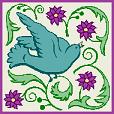
She believes that it is a gift to all people, Christian and non-Christian alike, for God wants people to live in blessed relationships with one another, and be happy.
She believes, though, that Christian Sacramental Marriage is the perfect expression of this state of life. Sacramental Marriage places the man and the woman in a spiritual relationship in Christ, as well as a legal and social relationship.
She also believes that the family created by a married couple is intrinsically more stable, and able to provide the best environment for the bringing-up of children.
Underlying this teaching, the church believes that marriage is a permanent state, and the promises made are binding for life.
Although increasing numbers of people, for one reason or another, feel unable to accept the Church's teaching on marriage, and particularly that it is 'for life', they still come in quite large numbers to be married in Church.
There is still an almost instinctive feel that 'one plus one equals one'; that a man and a woman in marriage become something new, even 'one flesh'!
The Marriage service in Church presents the Church's teaching in a dramatic way. It gives a refreshing emphasis to the spiritual dimension, as distinct from the monetary and social dimensions, which can so easily dominate.

Starting at the main door, the procession wends its way to the front of the church where the Groom and Best Man wait.

The Bride walks on the right of her father, or father's stand-in. She is preceded by the Priest, and followed by the Bridesmaids.

On reaching the front of the church the service begins with prayers, readings from the Bible, and an explanation of the service and the nature of married life.
This is followed by an invitation to anyone present, including the Bride and Groom, to make public anything that might prove an obstacle to a legal marriage, for example already having a wife in a foreign port!
They also declare, publicly, their intention to remain married to each other for the whole of the rest of their lives. This is followed by the 'giving-away' of the Bride by her father, or transfer of responsibility for her well-being.
This ceremony was of particular importance in the past when wives were generally wholly dependent upon their husbands.
The vows are Solemn because they are made in the presence of Almighty God, but they are made to each other. In other words God is asked to hold the parties to their promises.
The promise, or vow, covers all aspects of life and does not allow any excuse or reason for breaking one's side of the bargain.
It is, put simply, to dedicate oneself exclusively to the happiness of the other person, without stint and whatever the cost to oneself.
The only way of terminating the relationship, allowed for, is the death of one or both of the persons!
For this reason, and because Christ explicitly and categorically forbade it, the Catholic Church, including much of the Church of England, does not allow the remarriage of divorcees in Church except under special conditions.
The Groom then places the ring on the third finger of the Bride's left hand (third finger as a reminder of God the Holy Trinity).

It is gold as a token and symbol of all the earthly possessions of the Groom, which he is bestowing unconditionally upon his Bride.
It is often customary nowadays for the Bride to give a ring, in the same way, to the Groom.
The couple are now pronounced married, and from that moment-on are man and wife.

In one final symbolic action the Priest joins the right hands of the Bride and Groom and 'ties' them together with the priestly stole he is wearing. In words he forbids anyone from causing them to separate.
There then follows the first of two blessings given by the Priest.
This is the Nuptial Blessing, given specifically to the newly-weds.

The second, at the end of the service, is the general blessing given to all the people present.
This means that the first thing that the couple do together in their married life is worship God.
At the end of the service the newly-weds are required to sign the registers and Marriage Certificate, along with two witnesses. Finally the newly-weds lead the procession out of Church.

Our Services Explained
Eucharist
Baptism
Confirmation
Confession
Ordination
Index